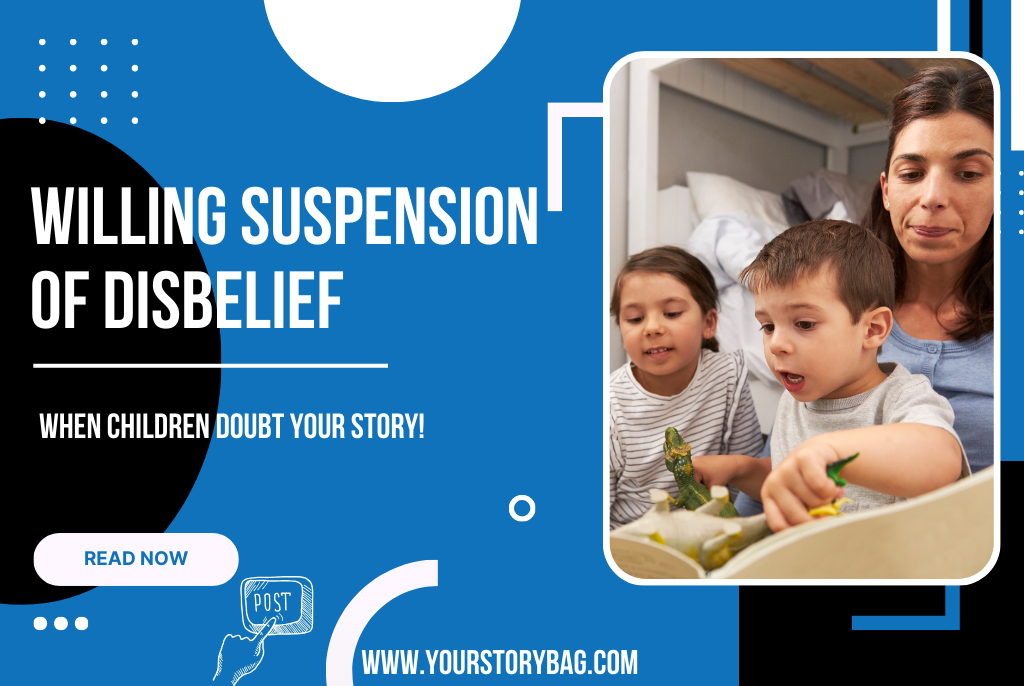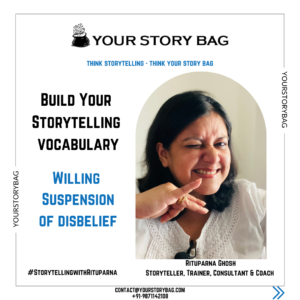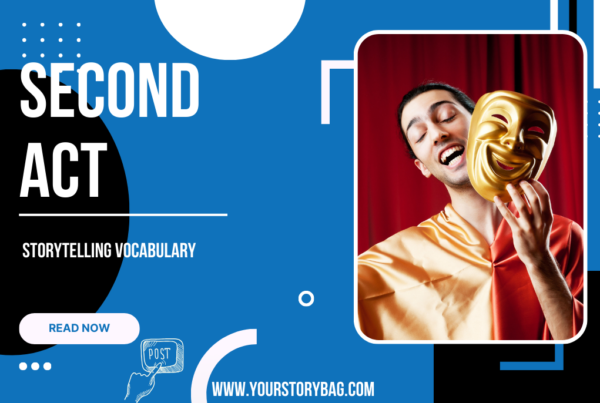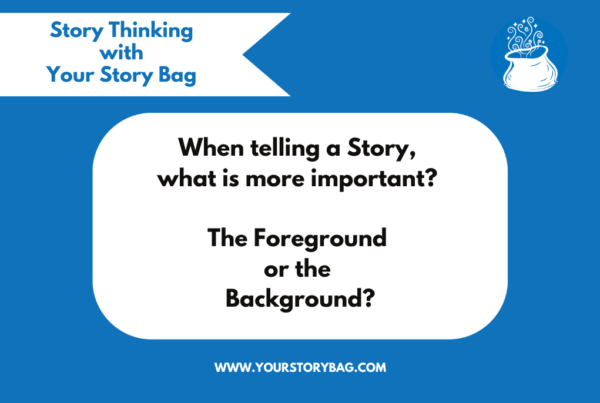
“I don’t believe your story. This is not real,” protested a 7-year old in my storytelling session. I was to trying to tell them the story of the time when the Sun got upset and went away from Earth. She was the only one who refused to believe me. The other 29 pairs of eyes turned towards me waiting for my response.
The relationship between a performance storyteller and a child is like that of a magician and the enchanted. A storyteller tells every story like it happened before them. When I tell, I rely on the audience to surrender to the story and not question it. I want them to step into the realm of a story and participate in it as a character. In other words, I want them to experience Narrative Transportation. It’s easy to assume that children don’t snap out of stories so easily, especially when they are so young. However the truth is children have a keen sense of their reality. They are curious. They don’t mean to say that you are lying. But they do know that you’re not telling the truth.
This incident sparked a journey into the realms of psychology, research, and human response to stories, leading to an exploration of the concept known as the “Willing Suspension of Disbelief.”
If you’re a storyteller, then read on.
Let’s look at how and why humans, particularly children, respond to stories.
 Understanding Willing Suspension of Disbelief:
Understanding Willing Suspension of Disbelief:
The term “willing suspension of disbelief” was coined by the poet and philosopher Samuel Taylor Coleridge in the 19th century. It refers to the audience’s willingness to temporarily accept the implausible or fantastical elements presented in a story for the sake of enjoyment. In the realm of storytelling, it serves as the bridge between reality and fiction, enabling listeners to immerse themselves in the narrative. This phenomenon plays a pivotal role in the effectiveness of storytelling across various platforms, from traditional oral tales to modern fiction.
Psychology of Storytelling:
Numerous psychological studies have explored the deep-seated human inclination to engage with stories. Neuroscientist Paul J. Zak‘s research on the impact of storytelling on the brain reveals that narratives, especially those with emotionally charged elements, trigger the release of oxytocin, a hormone associated with empathy and bonding. This physiological response strengthens the connection between the storyteller and the audience, fostering a more profound engagement.
Furthermore, psychologist Keith Oatley’s work emphasizes the role of fiction in enhancing empathy and understanding. The ability to step into the shoes of fictional characters and experience their lives allows individuals to navigate diverse perspectives, ultimately shaping their own emotional intelligence.
Children and the Challenge of Belief:
Children, with their unbridled curiosity and vivid imaginations, are both the toughest critics and the most fervent believers in the world of storytelling. Cognitive psychologist Jean Piaget‘s theory of cognitive development suggests that children progress from a concrete operational stage to a more abstract and imaginative stage. This transition influences their ability to navigate the willing suspension of disbelief. While some children might readily embrace fantastical elements, others, like the 7-year-old skeptic, may be in a stage where they are testing the boundaries between reality and fiction.
Stories Children Trust:
In my experience as a Children’s Storyteller, I have noticed that children believe stories where they can see themselves. They like stories that pique their curiosity and take them to experiences that are new to them. In one of my most popular stories I have children climb an imaginary tree with me. While many urban children have never climbed a tree (and don’t believe that I would have ever climbed one), they willingly surrender to the make-believe act of climbing one. We climb our own trees, describe what we see, how we feel and then respond to our emotions. This small participatory trope encourages children to stay in the moment and travel to new dimensions.
How we Tell Stories:
Maybe it is something about the way we tell stories? Many of us begin our stories with “Once Upon a Time…” It is US who tell them that such things have happened in the past. So the fault is ours!
I took this experience to my (more experienced) storyteller friends and asked them if they have tackled such questions from children. Here are some their responses.
Richard Marsh | “One of my replies is, “It happened in the Land of Story, and anything can happen there.”
Timothy Jennings | I might say, “it’s a story,” if pressed, “its fiction.” If pressed further, “like a movie or a comic book.” I don’t say “or the Bible,” even here in the least religious state of the USA. I might say “or Hercules,” though.
Patricia Coffie | I’ve been telling personal and family stories for more than 50 years. I sometimes begin by saying “Not so long ago and not so far away…” and to the question of truth I answer “That story is as true as I can make it.” These are remarkable stories of ordinary people accomplishing extraordinary things and we need that to survive “Breaking News.”
Wendy Mages | I think making distinctions between what is true and what is false, what is scientific fact and what is myth, what is fiction and what is nonfiction is still important both in terms of child development and in terms of our modern reality with AI and deep fakes.
So, I think I might respond by asking the child a question. I might say something like:
“That’s an interesting observation. I wonder, why do you think people might want tell stories about things that cannot really happen in real life?”
I would listen to the child’s answer and respond as best I could. Then, I might ask, “If the story I told could not really happen in real life, what do you think it means? Is there a lesson in this story that we might be able to learn from or use in real life?’
Bob Kanegis | After a library performance I ran into one of the 4 year old listeners in the parking lot (with his mom). He had a book in his hand he’d just checked out so I asked him what he was reading. He showed me the book… The Cow That Went Oink.
In what I thought was a mock serious tone I said, ” Cows don’t go oink.
He looked at me quizzically, seemingly in disbelief that an adult could be so dense and shot back,
” Well in THIS book, THEY DO!”
Michael J Bennet | When my daughter was little, we would classify stories into three categories.
- True story. Personal, family, historic stories fall here.
- Could be true story. This is something that doesn’t violate any laws of physics. No magicians, talking pheasants, no mountains made of slippery glass.
3. Not true story. These still give us a chance to discuss characters, decision making, bravery, risk/reward, and what we would do in the same situation. Coyotes and Road Runners always fall into this category. Even if it’s not true, there’s still something to learn.
Richard Martin | I have generally found children can understand when I suggest that stories work on a different level of “truth” to our everyday level of reality. I.e. a story can have “something” which is “true”, even though that story didn’t happen. There may be the occasional child who is determined not to accept that: a rare failure of imagination which is simply sad.
[I particularly like Richard Martin’s long list of story beginnings and endings. If you are a storyteller worried about your little audience doubting your story, keep this list handy!]
Laura Simms |When children ask me, “was that true?” I make the distinction Ithat there is truth in the story. Or, I might say, it is like a dream. You imagine it and it feels real.
I might add that how a story is heard not only depends on the listener, but the storyteller’s recognition of what is alive in the story beyond the entertainment factor or the analysis. the older that I get, the more regard I have for the deep work that is sometimes needed in telling a story to children.. work on myself actually, and on the way a story is experienced (not how each person hears it but the experience of the story as a story that is far more than the outer content)
Connie Regan Blake | I always say, “All the stories I tell hold truth.” Or “I only tell stories that hold the truth.” That seems to satisfy most folks!
Fran Stallings | I think it was Donald Davis who said, “Some things that are True, never happened. And some things that have happened aren’t True.” I think that is an excellent reply for a thoughtful adult listener, but not what a kid can make sense of.
Navigating Skepticism:
As storytellers, educators, and parents, it is crucial to navigate skepticism without stifling the inherent curiosity that fuels the willing suspension of disbelief. Encouraging questions and discussions around the stories can help children understand the distinction between fiction and reality. Refrain from saying things like, “This is just a story! Such things happen.” Instead pivot them to go beyond the doubt and acknowledge their ‘critical thinking’ abilities.
Celebrate Doubt!
When a child raises a doubt about your story, take a moment to celebrate! Don’t panic. This means that you have a thinking child, one who is aware of his / her knowledge and experience. It means that the child is willing to apply prior knowledge, critically think, problem solve and apply one’s higher order thinking skills. The fact that they question is an indication of the fact that they are not willing to be told things that don’t understand or believe. In other words, they are not gullible. Don’t let the questions slow you down. Instead, take them in your stride and look at how you can satisfy them without shutting them down. You cannot tell them what to think, instead, give them something to be curious about and you would have a willing listener.
What did I say?
I am sure by now you’re wondering how did I tackle the situation. Mine was a child friendly version to what I always say about stories:
- At any given point of time we know only 1 story…the one we are living in. Yet, there is the possibility of “What If?”, another world where the events in our stories are happening, will happen or have happened.
- It’s perfectly all right to question a story, not wanting to imagine a world without water, Sun, air etc etc…Yes, it’s scary. I promise we will find a way to solve it in the story.
- If you can allow yourself to leave that question and enter the story verse as a character then you get to decide the consequences…
- My job is to make you ‘travel through space and time’, you can decide whether to stay here or travel with me.
- You don’t have to believe me now. Listen in, let the story be told and then you can decide whether you believe it.
Storytelling is a dynamic art that is constantly being shaped by the storyteller and the listener. Whether you’re working as a professional storytelling artist, a parent telling stories to your child, a teacher using stories in the classroom, or a storyteller looking to gather up an audience, we have the right steps laid out for you.
Look up Tickle Your Story Bones and Spark Classrooms, our Storytelling Programs that help parents, teachers and storytellers work with children across the ages.







Great article, Rituparna. I always say to the children who question the ‘truth’ of a story, ‘There is a grain of truth in every story. Do you know which part of this story was true?’ Then, the discussion leads both myself and the children into new areas of understanding.
Many thanks,
Allison Galbraith – Storyteller & Folklorist
That’s such a terrific way to expand the experience for both the storyteller and the listener!